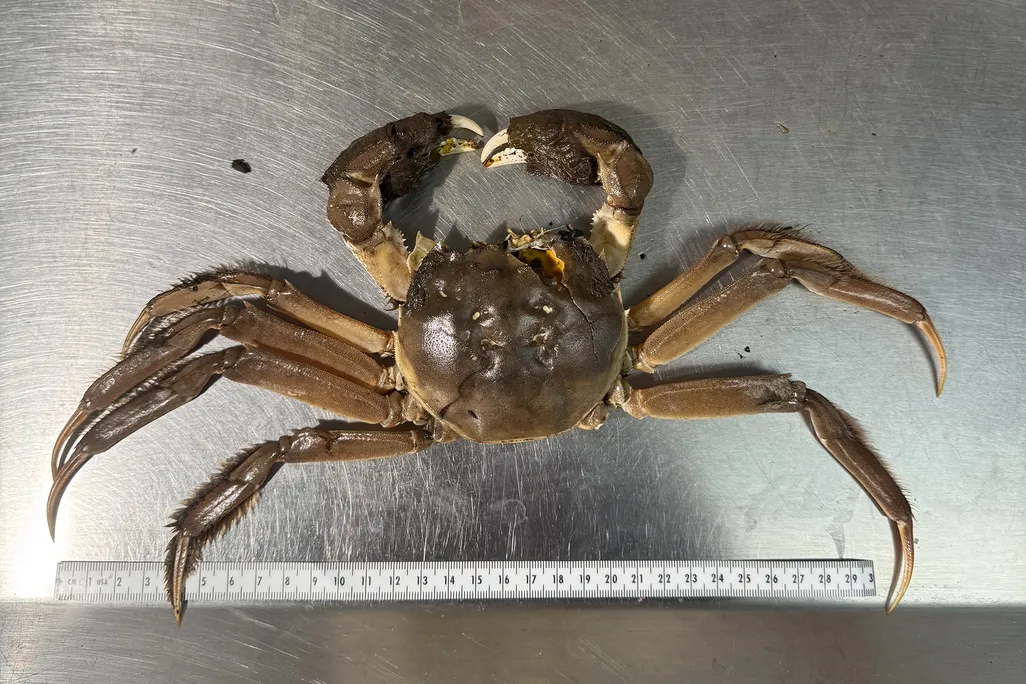WWW.SMITHSONIANMAG.COM
Invasive Crab With Furry, Mitten-Like Claws Detected for the First Time in the Pacific Northwest
Invasive Crab With Furry, Mitten-Like Claws Detected for the First Time in the Pacific Northwest
A commercial fisherman nabbed a large male Chinese mitten crab in the lower Columbia River late last month, putting biologists on high alert
Chinese mitten crabs had never been found in the Pacific Northwest, until now.
Oregon Department of Fish and Wildlife
A Chinese mitten crab has been caught in the Pacific Northwest for the first time, raising concerns about the spread of the highly invasive species.
According to an alert from the Oregon Department of Fish and Wildlife, a commercial fisherman caught the crustacean on April 22 in the lower Columbia River, which serves as the border between Oregon and Washington. The fisherman discovered the invasive creature east of Tongue Point, a small peninsula that juts out into the river near the city of Astoria.
After making the unexpected catch, the angler took the critter to the Oregon Department of Fish and Wildlife, where a shellfish biologist confirmed it was a Chinese mitten crab (Eriocheir sinensis).
The animal is a large male that may have hitched a ride as a larva in the ballast water of a boat. Or, authorities say, it could have been illegally introduced to the Columbia River by a person releasing it into the wild. (Chinese mitten crabs are a prohibited species in Oregon.)
State biologists are now working with their counterparts in neighboring Washington and at the National Oceanic and Atmospheric Administration (NOAA) to learn whether other Chinese mitten crabs are lurking in the waterway. They plan to set up trap lines and gather water and sediment samples to look for the species’ genetic markers in the environment.
This is the first confirmed sighting of the invasive species in the Pacific Northwest. But Chinese mitten crabs are nothing new in North America.
They first established a foothold on the continent in the 1980s in California’s San Francisco Bay, where fishermen were catching between 100,000 to 800,000 crabs per year in the late 1990s, according to the Smithsonian Environmental Research Center (SERC).
“It was spectacularly abundant. A true outbreak,” SERC biologist Greg Ruiz told the center’s Kristen Goodhue in 2018.
The crabs caused “significant infrastructure and ecological damage” in California, which is why officials with the Oregon Department of Fish and Wildlife are encouraging members of the public to report any and all sightings.
Chinese mitten crabs can easily be mistaken for native species, but authorities in Oregon are encouraging members of the public to report any and all sightings.
Oregon Department of Fish and Wildlife
Chinese mitten crabs haven’t been detected in San Francisco Bay since 2010, but they have started to crop up elsewhere—including along the East Coast between Maryland and Connecticut. Chinese mitten crabs have also occasionally been found on the Gulf Coast and in the Great Lakes, but they don’t appear to have established breeding populations in those places.
In recent years, the crabs have also been spreading across the United Kingdom, where authorities are experimenting with traps to prevent them from migrating to downstream breeding grounds.
Chinese mitten crabs have some unusual features, including their namesake furry, mitten-like claws. They also have four spines on each side of their shells, plus a notch between their eyes. The crabs vary in color but tend to fall somewhere along the brownish-orange to greenish-brown spectrum. But even though their appearance is so distinctive, Chinese mitten crabs are not easy to identify and can easily be mistaken for native crab species—and vice versa.
The crustaceans typically live in freshwater, but they must migrate to saltwater to reproduce. And Chinese mitten crabs are prolific parents: Adult females can carry between 250,000 and 1 million eggs.
When those eggs hatch, the crab’s larvae live briefly in saltwater bays and estuaries. Once they mature to become fully molted juveniles, the crabs make their way a few miles upstream to brackish and freshwater areas.
Chinese mitten crabs originated in East Asia, where they remain a popular delicacy in some regions. But the crabs are banned in the United States and the United Kingdom, where they are considered invasive. In these countries, the sale, export, import, purchase and acquisition of Chinese crabs is prohibited unless you have a permit.
Biologists say the crustaceans are problematic, because they outcompete native species for food and habitat. In addition, their burrows can damage or weaken levees, dikes and stream banks. In California, they’ve also clogged fish salvage structures, used to collect and relocate fish, at water diversion facilities.
Anglers dislike the crabs, because their sharp claws can damage fishing gear. And, in some places, the crafty crustaceans have also been caught nabbing anglers’ bait and catch.
However, containing the crabs is no easy feat. Adults can live for about a week in a dry environment or for more than a month in a damp meadow, according to the U.S. Bureau of Reclamation. They’re capable of scaling concrete structures that are between 10 and 13 feet tall and are known for being “one of the best climbers” among crab species, per the federal agency.
“Mitten crabs can also pass through lock systems and possibly climb fish ladders, or leave the water and walk around barriers where the terrain is suitable,” according to the bureau.
Get the latest stories in your inbox every weekday.
